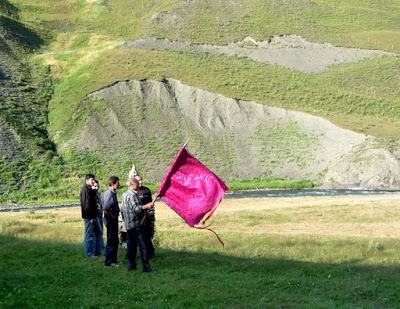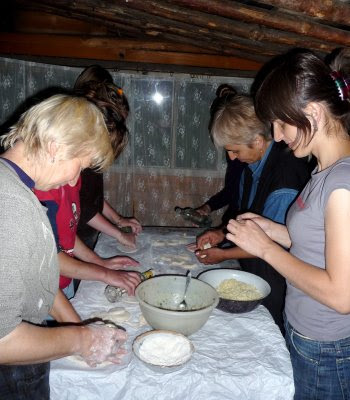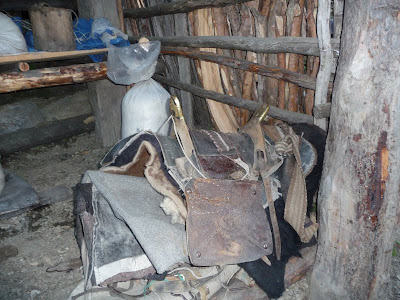Tusheti can be reached with a 4WD vehicle and only a 4WD.Well some take a helicopter but I have no idea how. The journey starts from Pshaveli (Kakheti) with the road taking you over the Abano pass (2926 mts asl) and onto Omalo, the main village of Tusheti. The pass, built in 1978, is only open during the summer months from around May until to October –Note for travellers: some homestays are often only open from July but a bit a preplanning will always ensure you have somewhere to stay.
The following pictures are just a taste of the tough and exciting journey to Tusheti.


 The road up to the pass , if you can call it that, is a white knuckle drive of the first order with waterfalls cascading onto the road creating what the Tush refer to as ‘their own natural car wash’. Well it gets the car clean.
The road up to the pass , if you can call it that, is a white knuckle drive of the first order with waterfalls cascading onto the road creating what the Tush refer to as ‘their own natural car wash’. Well it gets the car clean.

On the way up to the pass you will see by the roadside a sign pointing out a local Spa . Although basic ,this Spa is known by Tushetiens as a giver of life with the potential for revitalising the body and sorting out all manner of ailments. I've never been there but I am told it is worth a visit .You can't miss it if you ask any local. The sign to the spa is at a bend in road which I appreciate is rubbish information since the road bends all the time.
Once over the magnificent Abano pass (don’t miss the wild flowers and keep an eye out for the cloud cover) the journey gets more exciting, depending on the previous winter that is. In the summer of 2008 the road cut through the previous winter’s snow approx 4 meters deep, and that was in July. In the summer of 2009 there was a period in late July when the rain fall made part of the road impassable for a while but this is not uncommon. The road will always dry out you might just be held up for a couple of days.

 Following the river, deep into Tusheti the road is often subject to land slides after heavy weather. The landscape is made up from a mixture of shale and rock knitted together by centuries of alpine woods.
Following the river, deep into Tusheti the road is often subject to land slides after heavy weather. The landscape is made up from a mixture of shale and rock knitted together by centuries of alpine woods.

 The debris of ice and rock covering over the torrent of the mountain river illustrates just how violent the previous winter must have been.
The debris of ice and rock covering over the torrent of the mountain river illustrates just how violent the previous winter must have been.

 This is a picture of me and my wife Melissa standing by some of the snow left from the previous winter in 2007/8 and yes it is July.
This is a picture of me and my wife Melissa standing by some of the snow left from the previous winter in 2007/8 and yes it is July.
 This view from within our 4WD illustrates how deep the snow can get as we make our way to Tusheti. On other occasions our trusty Lada drove over the snow and debris crablike, slowly inching our way across the compacted snow in what felt like a challenge from the elements to test our determination to travel to Tusheti .
This view from within our 4WD illustrates how deep the snow can get as we make our way to Tusheti. On other occasions our trusty Lada drove over the snow and debris crablike, slowly inching our way across the compacted snow in what felt like a challenge from the elements to test our determination to travel to Tusheti .

This journey, never to be missed, can take as long as six hours to Omalo depending on the conditions and as little as four hours if traveling in a smart 4x4.
As a rule of thumb if you are traveling in a Niva or Lada reckon on five to six hours and a Mitsubishi type 4x4 will be a lot quicker and more comfortable.
On arrival you will see Tusheti has two Alazani rivers that join close to the village of Shenako, near Omalo.The combination of these two rivers flow out of Georgia where it crosses into Dagestan and onto the Caspian Sea. More of this later
To understand the lay of the land ,although it is not important to the traveller Tusheti is divided into four communities:
The villages situated in Pirikiti Alazani river gorge, unsurprisingly ,are known as the Pirikit Community.Villages in the Gomertsi Alazani gorge are referred to as the Gomertsi Community. And villages in the valley of the Tsuata Tskali river are known as the Tsova Community. The last community are the Chagmis who are located in the valley of the two Alazani rivers and the administrative center of Tusheti – Omalo
Omalo is the largest village in Tusheti and regarded by some as the center of administration and a good starting point when embarking on a trip around Tusheti.
On arrival you will be stunned by the exceptional scenery whereever you look.

A spectacular mix of, snow-covered, rocky peaks, deep gorges, and soft, grassy hillsides peppered with flocks of the indigenous sheep. Sadly the Tusheti vernacular architecture is not evident in Omalo ,which is still suffering from the brutalism of Soviet Russia.
 The image above offers an idea of Omalo and the image below illustrates the approaching meadow which must be one of the finest wildflower meadows I've ever encountered and one of Tusheti's great untold secrets .
The image above offers an idea of Omalo and the image below illustrates the approaching meadow which must be one of the finest wildflower meadows I've ever encountered and one of Tusheti's great untold secrets .
 If you have the energy make your way to Upper Omalo , the old village.
If you have the energy make your way to Upper Omalo , the old village.
 This is me looking down on Upper Omalo with a tower restored by the 'Keslo foundation' to my left. Keslo meaning strong or tough.
This is me looking down on Upper Omalo with a tower restored by the 'Keslo foundation' to my left. Keslo meaning strong or tough.
In Upper Omalo you will be able to see the recently restored Keslo towers and some great examples of local traditional construction. There are also excellent Guest Houses to be found, as there are in Omalo.
Note: I understand Upper Omalo has now been developed (2013) and some say has lost it's character.
An important point to grasp is as a rule there is no running water and electricity in Tusheti is scarce. If is does exist it is generally generated localy via Solar . This isn’t a problem but if you are a western city slicker treat the experience as a novelty and think of the romantic side to such an experience. Eating by candlelight and showering with a bucket of warm water is something we can all get use too and remember, you will begin to connect with the wild after a short while .
 This Khatis(shrine) is from Gogurlta
This Khatis(shrine) is from Gogurlta
Once you make your way by what ever route into Tusheti you will find evidence of its old animist religion. You will come upon stone shrines known as khatis, sometimes decked with the horns of sacrificed goats or sheep and possibly a bell. Women
are not permitted to approach these shrines and please please don’t think how silly. This is a very important aspect of the Tushetian culture and insulting to the Tush if, as a women, you choose to disregard their custom.
More of this later .
 This is the ' Kamaz' 6x6 super truck or Soviet monster of the highways . In my day this took passengers and general provisions on a daily basis to Omalo. This great beast winds its way up over the pass to Tusheti at a snails pace. Each bend in the road must be taken with precision and nerve by its driver. The road to this wilderness was not built for monsters like the Kamaz. I prefer the nimble 4WD Lada's/Niva's who seem to take the road in their stride.
This is the ' Kamaz' 6x6 super truck or Soviet monster of the highways . In my day this took passengers and general provisions on a daily basis to Omalo. This great beast winds its way up over the pass to Tusheti at a snails pace. Each bend in the road must be taken with precision and nerve by its driver. The road to this wilderness was not built for monsters like the Kamaz. I prefer the nimble 4WD Lada's/Niva's who seem to take the road in their stride.
Sadly I understand this truck no longer tales passengers. If does have been warned, this truck is not for the faint hearted unless you are looking for a story to share with your friends and remember you might need wet weather gear and something warm when you go over the pass.This is no joke.
Getting there
The following information might be useful when making plans to travel to Tusheti, however my advice is: Never presume anything will run on time. And work on the assumption something may need to be fixed along the way . This is not the rule but it’s best to set expectations and you won’t be disappointed. What can be guaranteed when traveling to Tusheti is some genuine excitement with life pitching up with some exceptional experiences along the way. One other point to make to the uninitiated is when you hire a 4WD with driver don't presume it is for you alone . Friends may pitch up and take a ride, other drivers will wish to pass the time of day and this can take a while and you might find yourself stopping for an unexpected lunch along the way . Anything can happen.
Try these numbers for local drivers
: Vaja idoidze-599 74 87 62 Dato Idoidze- 593 76 91 35 , Bagater Zviadauri- 599 31 03 66
As I mentioned earlier my preferred choice of travel to Tusheti is the Lada or Niva 4WD or a Mitsubishi if you can find one. 4x4with drivers can be found in the small towns of Kvemo- and Zemo-Alvani in Kakheti. That's about 22km from Telavi ; I'm told by my daughter, who traveled in the summer of 2009, one should expect to pay around 200 to 220 Georgian Lari for a Niva/Lada for a one-way trip. These small white 4WD's can take three passengers but only two rucksacks possible three at a push . To find a car arrive in Alvani by 9am – the cars mostly leave from the central crossroads which is impossible to miss. If traveling by Marshrutnoye you can ask to be dropped off at the beginning of the road to Tusheti . I have found the drive from Kakheti to Omalo takes around 6 to 7 hours to cover 80 km and not 4 hours as some of the guides might tell you. If you speak Georgian ask your driver to travel
very slowly on the roads running up to the mountain trail. Any chance for the drivers to put their foot down, they will and you don't want to frighten the chickens do you?
For the cheaper and far less comfortable but even more exciting ride, try the Kamaz truck . It carries a mix of freight and passengers and cost a mere 20 GEL, that's standing in the back out in the open. Remember it can get very cold when going over the pass and there might even be cloud cover at 3,000 m. On the other hand it is easy to get sunburned so be prepared- take food, there are no fancy cafes on the way .This giant truck lurches its way precariously from Alvani up to Tusheti, taking around 8 to 9 hours to Omalo but that's an optimistic guess. I understand the Kamaz leaves any time between 6am and noon, once they have a fullish load.
You might like to consider a Marshrutnoye taksi ,otherwise known as a marshrutka to take you to Alvani from Tbilisi .The role of the modern marshrutka is similar to minicabs in other countries except there are sometimes some changes to the marshrutka which do allow for standing capacity.If it helps I'm told Marshrutkas run to Alvani from Telavi for 8 lari, 45 minutes, once or twice an hour, 9am to 5pm from the Ortachala bus station.
The following distances might help when planning a trip
Tbilisi – Telavi 160 km.·
Telavi – Pshaveli village 32 km.·
Tbilisi – Akhmeta 170 km.·
Pshaveli village – Omalo 72 km - a short distance but very slow trip
Tbilisi – Kvemo Alvani 190 km.·
Telavi – Kvemo Alvani 22 km.·
Akhmeta – Kvemo Alvani 16 km.·
Kvemo Alvani – Omalo 90 km.
When I wrote this entry in 2009 'You Tube' had just started showing Tusheti videos. In 2013 there are now plenty of examples . To get a true idea of the journey have a look at a couple of journey videos illustrating the nature of the drive and how difficult it is. If you are considering hiring a 4x4 my advice is
think again, you need a local who takes the trip all the time. This road is generaly regarded as one of the worst in the world.
For those of you who are lucky to have the spare cash you can take the helicopter to Tusheti from Tiblisi. My daughter caught the helicopter on her return in the summerof 2009 from Shenako kindly provided by one of the village elders . The following image is of the helicopter delivering provisions to the army but I know the helicopter will make bespoke trips.
 Once you have arrived in Tusheti the true mode of transport is the horse and we are not talking pack horses. These versatile, fleet of foot ponies have remarkable stamina. If you have the chance and can ride make the most of it and throw the rule book away. Tushetians will ride without stirrups and with any tack they can lay their hands on. Given the chance they will race at break neck speed just because they can.
This picture was contributed by giorgi bakuridze. Thanks Gio
Once you have arrived in Tusheti the true mode of transport is the horse and we are not talking pack horses. These versatile, fleet of foot ponies have remarkable stamina. If you have the chance and can ride make the most of it and throw the rule book away. Tushetians will ride without stirrups and with any tack they can lay their hands on. Given the chance they will race at break neck speed just because they can.
This picture was contributed by giorgi bakuridze. Thanks Gio































































.jpg)





